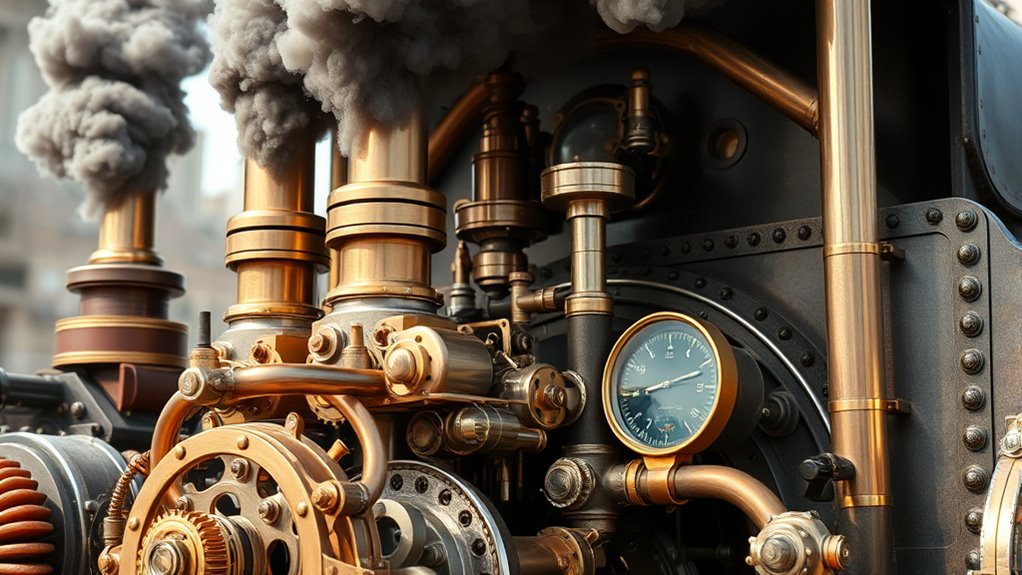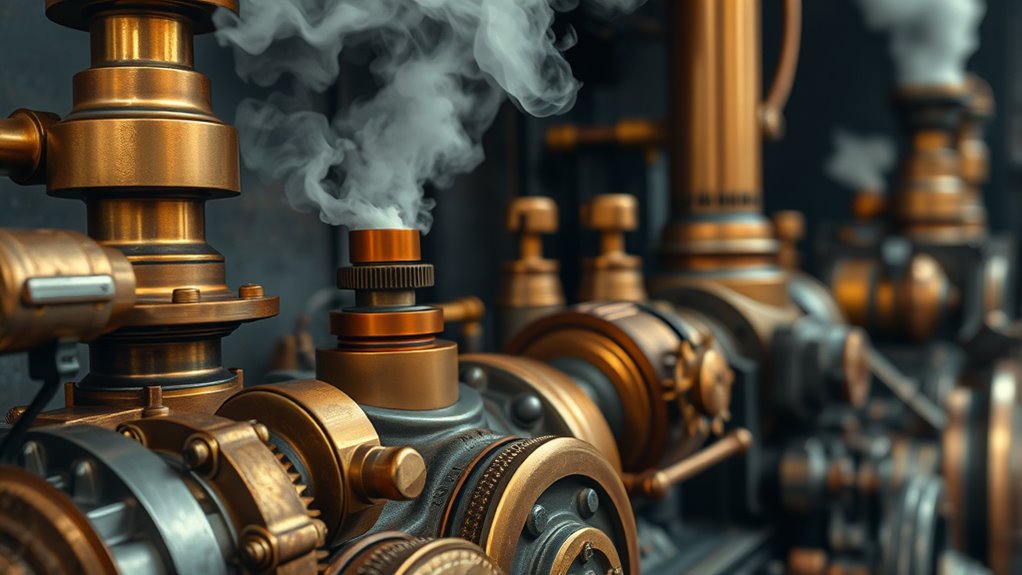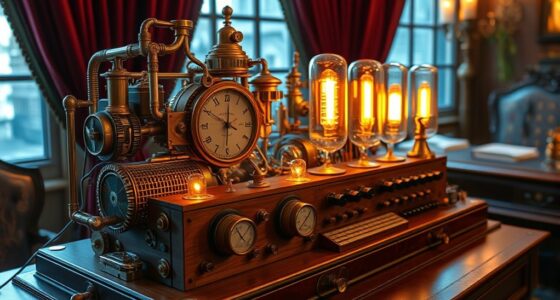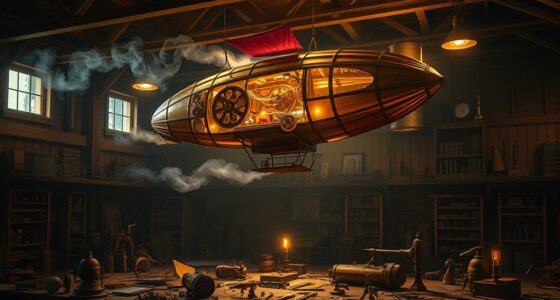Steam power relies on well-designed boilers that convert fuel into steam, which then drives pistons or turbines to produce motion. The efficiency depends on how well the boiler transfers heat, with innovations like multi-pass designs and stronger materials improving performance and safety. Advances in boiler technology made steam engines more powerful, reliable, and safer, fueling industrial growth and the classic steampunk aesthetic. Exploring this science reveals how these engines became iconic—keep exploring to uncover more fascinating details.
Key Takeaways
- Steam engines convert heat energy from burning fuel into mechanical power via steam pressure.
- Boilers are designed to optimize heat transfer, increasing efficiency and safety in steam engine operation.
- Multi-pass boiler designs improve energy extraction by allowing hot gases to flow through multiple layers.
- Advances in boiler materials and safety controls enabled higher pressures and longer, more reliable engine runs.
- Understanding boiler efficiency and heat transfer principles explains the core science behind steampunk-style steam engines.

Have you ever wondered how steam power transformed transportation and industry? It all begins with understanding the core components that make steam engines work so effectively: boiler design and steam engine efficiency. When you look at a steampunk contraption or a vintage locomotive, you’re witnessing the result of decades of engineering innovation. The boiler is the heart of a steam engine, responsible for generating the steam that powers the entire system. Its design determines how efficiently heat is transferred to water, affecting the overall performance. A well-designed boiler maximizes heat transfer while minimizing heat loss, ensuring that you get the most energy out of the fuel you burn. This efficiency is essential because it directly impacts how much work the engine can do with the least amount of fuel, making the entire process more economical and powerful.
Steam engine efficiency hinges on how well the boiler converts fuel into usable steam and how effectively that steam is utilized to produce mechanical work. Engineers have experimented with various boiler shapes, sizes, and materials to optimize this process. For example, the development of multi-pass boilers, which allow hot gases to flow through several layers before escaping, vastly improved efficiency by extracting more heat from the fuel. You can see that every tweak in boiler design was aimed at squeezing every ounce of energy from burning coal or wood, which was essential for powering everything from textile mills to locomotives.
Engineers optimized boiler shapes and materials to maximize heat transfer and efficiency in steam engines.
As you explore the science behind steampunk engines, you’ll notice that advancements in boiler design weren’t just about increasing power—they also improved safety and reliability. Early boilers often faced issues like explosions or rapid wear, but innovations such as thicker metal walls, better pressure controls, and water level indicators made them safer and more efficient. These improvements meant engines could run longer, with less downtime, and operate at higher pressures, which translated into more power without requiring larger boilers. Such engineering progress laid the groundwork for industrial growth, helping societies shift from manual labor to mechanized manufacturing and transportation.
In essence, understanding boiler design and steam engine efficiency reveals why steam power was such a game-changer. It’s not just about making engines run; it’s about optimizing every aspect of energy conversion. When you appreciate these details, you gain a clearer picture of how steam engines revolutionized industries and transportation, setting the stage for the modern technological world we live in today.
Frequently Asked Questions
How Do Steam Engines Compare to Modern Internal Combustion Engines?
Steam engines are generally less efficient than modern internal combustion engines due to differences in engine design and steam efficiency. While steam engines use boiling water to produce power, internal combustion engines burn fuel directly in cylinders, converting energy more effectively. You’ll notice that internal combustion engines offer better fuel economy and faster response times, making them more suitable for today’s transportation needs. However, steam engines still hold historical charm and engineering interest.
What Are the Environmental Impacts of Traditional Steam Power?
While traditional steam power might evoke images of progress, it also raises pollution concerns through coal combustion, releasing soot and greenhouse gases. You should consider its water consumption, as steam engines require vast amounts of water for operation, risking local shortages. This environmental footprint contrasts sharply with cleaner, more efficient modern technologies, reminding you of the importance of balancing innovation with sustainability.
Can Steam Engines Be Used for Renewable Energy Generation?
Yes, you can use steam engines for renewable energy generation by integrating solar power and hydrogen energy. You might harness solar energy to produce steam directly or use solar thermal systems to heat water. Hydrogen fuel cells can generate steam with minimal emissions, making the process cleaner. By combining these technologies, you create a sustainable system that reduces reliance on fossil fuels and promotes eco-friendly power production.
What Materials Are Best Suited for Building Steampunk-Style Engines?
If you’re building a steampunk engine, you’ll want to choose durable materials like metal alloys and heat-resistant ceramics. For example, using brass or copper gives that authentic vintage look, while heat-resistant ceramics ensure the engine can handle high temperatures without cracking. These materials balance aesthetics and functionality, making your engine both visually striking and operationally reliable. Don’t forget to take into account corrosion resistance for long-lasting performance.
How Does Steam Pressure Influence Engine Performance and Efficiency?
You’ll find that increasing boiler pressure boosts engine performance by delivering more power, but it also affects efficiency trade-offs. Higher pressure means hotter steam, which improves engine output, yet it can lead to greater wear and risk of failure. Balancing boiler pressure is key—you want enough to maximize power without sacrificing safety or efficiency. Adjusting pressure carefully guarantees your steampunk engine runs smoothly and effectively.
Conclusion
Think of steam engines as the heartbeat of steampunk worlds, pulsing with life and possibility. Just like a master conductor guiding an orchestra, you now hold the baton to understand their rhythm and power. As you journey forward, remember that behind every puff of steam lies a story of innovation and adventure. Embrace this knowledge like a compass, guiding you through the fascinating, mechanical symphony of steampunk engines. The adventure is just beginning.









